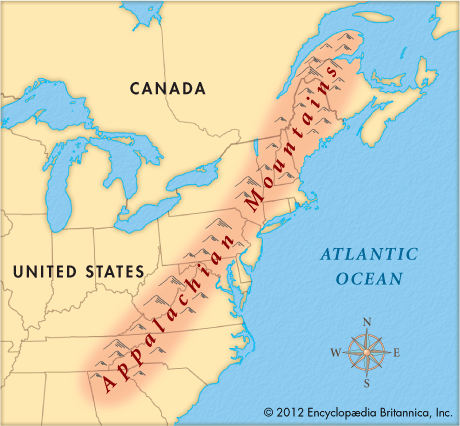Appalachian Mountains
THE APPALACHIAN Mountains of eastern North America comprise a north to south-tending range that extends for 1,600 mi (2,500 km) from the Gaspe Peninsula in Atlantic Maritime CANADA to northern ALABAMA in the UNITED STATES. Uplifted by the collision of continents ancestral to North America and Africa 270 million years ago, the Appalachian Mountains are the oldest mountain range in North America.
The Appalachian Mountains consist of a range of landforms from four physiographic provinces. The New England Province consists of rolling coastal lowlands and rugged interior highlands—like the White Mountains of NEW HAMPSHIRE and MAINE and the Green Mountains of VERMONT—of northern New England and Canada. The Ridge and Valley Province consists of long linear ridges separated by valleys with trellis drainage patterns. The valleys are rich in limestone that dissolves to produce sinkholes and underground caverns, producing KARST topography. The Ridge and Valley Province extends from NEW YORK to Alabama. The Blue Ridge Mountain Province extends from south-central PENNSYLVANIA to northern GEORGIA and is a rugged region of high relief with terrain that ranges from narrow ridges with steep slopes to broad mountains. The Appalachian Plateau (known as the Allegheny Plateau in the north and the Cumberland Plateau in the south) is a well-dissected plateau landscape with deeply eroded, dendritic drainage patterns. The Appalachian Plateau extends from New York to KENTUCKY. The northern Appalachian region from Canada to portions of northern Pennsylvania and NEW JERSEY was glaciated until 10,000 years B.C.E.

Elevation tends to increase from north to south in the Appalachian Mountains. In the north, the plateaus and low rounded mountains of the Gaspe Peninsula (the Shickshock Range) may exceed 4,000 ft (1,200 m) in elevation. Seven peaks in New Hampshire's Presidential Range exceed 5,000 ft (1,500 m). Mount Washington, at 6,288 ft (1,886 m), is the second-highest Appalachian peak. Elevation decreases somewhat in the central Appalachians, where ridges and peaks—like the Allegheny Mountains in Pennsylvania and VIRGINIA—generally average 3,000 ft (900 m). Elevations over 5,000 ft (1,500 m) begin in the Blue Ridge Mountains of southwestern Virginia, like Mt. Rogers at 5,729 ft (1,718 m) and Pine Mountain at 1,658 m (5,526 ft) and eventually exceed 5,526 ft (1,800 m ) in the Great Smoky Mountains of eastern TENNESSEE and western NORTH CAROLINA. The highest peak in the Appalachians (and the eastern United States) is Mt. Mitchell in the Black Mountains of North Carolina at 6,684 ft (2,037 m).
The climate of the Appalachian Mountains varies with latitude and elevation. Average annual temperature for Canada's Gaspe Peninsula is approximately 38 degrees F (3 degrees C). Annual precipitation averages 35 in (89 cm) in inland areas but may exceed 58 in (147 cm) along the coast. In the central and southern Appalachians, average annual temperatures may range from 50 to 64 degrees F (10 to 18 degrees C), respectively. Average annual precipitation ranges from 35 in (89 cm) in valleys of the central Appalachians to over 78 in (198 cm) in the high peaks of the southern Appalachians, the highest precipitation in the eastern United States.
The biological diversity of the Appalachian Mountains is rich and diverse, a product of varied climate, topography, and glacial history. In the Gaspe Peninsula and the high peaks of the Presidential Range, the summits are treeless and the vegetation is alpine, dominated by low-stature perennial herbs, shrubs, and graminoids and numerous lichens and mosses. Boreal species such as caribou occur in Canada's Shickshock Range and historically occurred in northern New England. Northern Appalachian forests include spruce-fir forests dominated by balsam-fir and red spruce and northern hardwood forests dominated by sugar maple, American beech, and yellow birch. Oak forests, dominated by northern red oak and white oak, become more common in the central Appalachians, particularly on drier slopes. The species-rich mixed mesophytic forest, with over 158 tree species, reaches its greatest development in the southern Appalachians. The southern Appalachians are also the world's center of diversity for the lungless salamanders, harboring 54 species. Many boreal species, like the northern flying squirrel and red spruce, also occur at high elevations in the southern Appalachians, relict survivors of the glaciation that drove them southward.
The Appalachian Mountains are rich in natural resources, particularly minerals and forest products. Coal, both anthracite and bituminous, is abundant in the Appalachians, particularly in the Appalachian Plateau, where oil and gas production is also centered. Limestone is quarried in the karst landscapes of the Ridge and Valley.